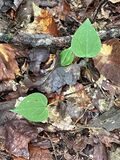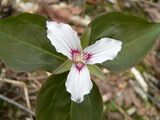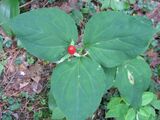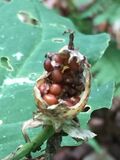Biology:Trillium undulatum
| Trillium undulatum | |
|---|---|
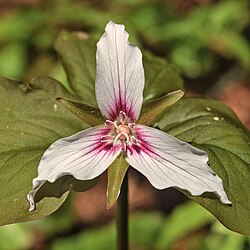
| |
| Blooming in Algonquin Provincial Park (Ontario, Canada). | |
| Scientific classification | |
| Kingdom: | Plantae |
| Clade: | Tracheophytes |
| Clade: | Angiosperms |
| Clade: | Monocots |
| Order: | Liliales |
| Family: | Melanthiaceae |
| Genus: | Trillium |
| Species: | T. undulatum
|
| Binomial name | |
| Trillium undulatum Willd.
| |
| Synonyms[2] | |
|
Trillium undulatum
| |
Trillium undulatum, commonly called painted trillium, painted lady (not to be confused with the painted lady butterfly), or trille ondulé in French,[3] is a species of flowering plant in the bunchflower family Melanthiaceae. It is also known as smiling wake robin or striped wake-robin.[4][5] The specific epithet undulatum means "wavy",[6] which refers to the wavy edges of the flower petals. The plant is found from Ontario in the north to northern Georgia in the south and from Michigan in the west to Nova Scotia in the east.[2]
Description
Trillium undulatum is a perennial herbaceous plant that spreads by means of an underground rhizome. It has three large leaf-like bracts arranged in a whorl about a scape (stem) that rises directly from the rhizome. The bracts (leaves) are ovate, each with a definite petiole (leaf stalk).[7]
Flowering occurs from late April to the end of June.[3] The single, terminal flower is pedicellate (on a stalk) with three sepals and three petals. The white petals have wavy edges and a central red to reddish purple splotch at the base of the flower.[8]
If the flower is successfully pollinated, a single fruit develops. Initially the fruit is green, ripening to a bright red by mid to late summer. The fruit is a berry-like capsule, 1 to 2 cm (0.5 to 1 in) long, with no ridges.[9] No other North American Trillium species has a fruit of this size, color, and shape.
Trillium undulatum is one of a dozen pedicellate-flowered Trillium species known to occur throughout its range, yet it is one of the easiest trilliums to identify. First check the leaves, each of which has a distinct petiole at least 4 mm (0.2 in) in length.[3] Other Trillium species occasionally have leaves with petioles, so check the pedicel (flower stalk) to confirm. The pedicel of T. undulatum is short and erect.[10] If the pedicel is greater than 5 cm (2.0 in) in length, or it is not erect, then it is not T. undulatum.
In general, the early life history of a Trillium species includes a one-leaf vegetative stage. A plant in this stage is recognized by the color, texture, and venation of the single leaf compared to the three leaves of a mature plant of the corresponding species. Populations of T. undulatum often have a large number of seedlings with a single leaf since individuals remain in the one-leaf stage for relatively long periods of time.[11]
Taxonomy
Trillium undulatum was first described and named by Carl Ludwig Willdenow in 1801.[12] A proposal to segregate T. undulatum (along with T. govanianum) into genus Trillidium Kunth was put forward in 2018.[13] The proposed grouping is based on phylogenetic analyses, pollen studies, and to a lesser extent, morphology.
(As of October 2021), Plants of the World Online (POWO) lists 8 synonyms for Trillium undulatum.[2] Although POWO accepts no infraspecific names, numerous forms have been described. In particular, Patrick described Trillium undulatum forma enotatum in 1985.[14] Unlike the typical form, forma enotatum has white petals with no red markings. Populations of this form have been found in the southern Appalachian Mountains of Georgia and North Carolina.
In addition, numerous abnormal forms have been reported,[15] including variants with multiple whorls of bracts, enormous sepals, or four or more parts (instead of the usual three), the latter being somewhat common in T. undulatum.[16]
Distribution
The range of Trillium undulatum extends from Ontario in the north to northern Georgia in the south and from Michigan in the west to Nova Scotia in the east. The species is known to occur in the following provinces and states:[2][3][17]
- Canada: New Brunswick, Nova Scotia, Ontario, Prince Edward Island, Quebec
- United States:[18] Connecticut, Georgia, Kentucky, Maine, Maryland, Massachusetts, Michigan, New Hampshire, New Jersey, New York, North Carolina, Ohio, Pennsylvania, Rhode Island, South Carolina, Tennessee, Vermont, Virginia, West Virginia
T. undulatum demands strongly acidic, humus-rich soils and tends to be found in the shade of acid-loving trees such as eastern white pine, red maple, red spruce and balsam fir. Although the soils that support it have low base saturation, this species was found to have relatively high levels of calcium, magnesium, and especially potassium in its foliage.[3][19]
(As of October 2019), Trillium undulatum is globally secure.[1] It is vulnerable (or worse) in at least seven U.S. states. In particular, it is endangered in both Ohio and Michigan.[20][21]
Bibliography
- Case, Frederick W.; Case, Roberta B. (1997). Trilliums. Portland, Oregon: Timber Press. pp. 149–153. ISBN 978-0-88192-374-2. https://archive.org/details/trilliums00case.
- Weakley, Alan S. (2020). "Flora of the southeastern United States". University of North Carolina Herbarium, North Carolina Botanical Garden. pp. 201,202,203. https://ncbg.unc.edu/research/unc-herbarium/flora-request/.
References
- ↑ 1.0 1.1 "Trillidium undulatum". NatureServe, Arlington, Virginia. https://explorer.natureserve.org/Taxon/ELEMENT_GLOBAL.2.158266/Trillidium_undulatum.
- ↑ 2.0 2.1 2.2 2.3 "Trillium undulatum Willd." (in en). Royal Botanic Gardens, Kew. http://www.plantsoftheworldonline.org/taxon/328444-2.
- ↑ 3.0 3.1 3.2 3.3 3.4 Case Jr., Frederick W. (2002), "Trillium undulatum", in Flora of North America Editorial Committee, Flora of North America North of Mexico (FNA), 26, New York and Oxford, http://www.efloras.org/florataxon.aspx?flora_id=1&taxon_id=242102016
- ↑ Keyes, Florence J. (January 1927). "Trillium grandiflorum in Maine". Rhodora (New England Botanical Club, Inc.) 29 (337): 15. https://www.biodiversitylibrary.org/item/14499#page/18/mode/1up. Retrieved 8 September 2020.
- ↑ Case & Case (1997), p. 149.
- ↑ Gledhill, David (2008). The Names of Plants (4th ed.). Cambridge University Press. p. 393. ISBN 978-0-521-86645-3. https://books.google.com/books?id=NJ6PyhVuecwC.
- ↑ O'Connor, R. P.; Penskar, M. R. (2004). "Special plant abstract for Trillium undulatum (painted trillium)". Lansing, MI, USA: Michigan Natural Features Inventory. http://mnfi.anr.msu.edu/abstracts/botany/trillium_undulatum.pdf.
- ↑ Stritch, Larry. "Painted Trillium (Trillium undulatum)". United States Forest Service. https://www.fs.fed.us/wildflowers/plant-of-the-week/trillium_undulatum.shtml.
- ↑ "Painted Trillium (Trillium undulatum)". http://wildadirondacks.org/adirondack-wildflowers-painted-trillium-trillium-undulatum.html.
- ↑ Case & Case (1997), p. 151.
- ↑ Weakley (2020), pp. 201,202.
- ↑ "Trillium undulatum Willd.". International Plant Names Index (IPNI). Royal Botanic Gardens, Kew. https://www.ipni.org/n/328444-2.
- ↑ Weakley, Alan S.; Sorrie, Bruce A.; LeBlond, Richard J.; Poindexter, Derick B.; Floden, Aaron J.; Schilling, Edward E.; Franck, Alan R.; Kees, John C. (2018). "New combinations, rank changes, and nomenclatural and taxonomic comments in the vascular flora of the southeastern United States. IV". Journal of the Botanical Research Institute of Texas 12 (2): 477–478. https://journals.brit.org/jbrit/article/view/950. Retrieved 3 October 2021.
- ↑ Patrick, Thomas S. (1985). "Trillium undulatum forma enotatum, a new petal color form of the painted trillium". Rhodora 87: 157–158. https://www.biodiversitylibrary.org/item/24163#page/160/mode/1up. Retrieved 3 October 2021.
- ↑ Deane, Walter (February 1908). "Some Teratological Forms of Trillium undulatum". Rhodora (New England Botanical Club, Inc.) 10 (10): 21–24.
- ↑ Fernald, M. L. (1943). "Trillium undulatum Willd., forma Cleavelandicum (Wood), comb. nov.". Rhodora 45: 517. https://www.biodiversitylibrary.org/page/609970#page/604/mode/1up. Retrieved 3 October 2021.
- ↑ "Trillium undulatum", State-level distribution map from the North American Plant Atlas (NAPA) (Biota of North America Program (BONAP)), 2014, http://bonap.net/MapGallery/State/Trillium%20undulatum.png, retrieved 11 October 2019
- ↑ "Trillium undulatum", County-level distribution map from the North American Plant Atlas (NAPA) (Biota of North America Program (BONAP)), 2014, http://bonap.net/MapGallery/County/Trillium%20undulatum.png, retrieved 11 October 2019
- ↑ T.G. Siccama, F.H. Bormann and T.E. Likens. The Hubbard Brook Ecosystem Study: Productivity, Nutrients and Phytosociology of the Herbaceous Layer. Ecological Monographs Vol.40, No. 4, Autumn 1970.
- ↑ "Rule 1501:18-1-03". https://codes.ohio.gov/ohio-administrative-code/rule-1501:18-1-03.
- ↑ "Trillium undulatum". https://mnfi.anr.msu.edu/species/description/15484/Trillium-undulatum.
External links
| Wikimedia Commons has media related to: |
- Citizen science observations for Painted Trillium at iNaturalist
- Trillium undulatum, Lady Bird Johnson Wildflower Center, University of Texas at Austin, http://www.wildflower.org/plants/result.php?id_plant=TRUN, retrieved 5 October 2021
- "Painted Trillium (Trillium undulatum)". http://ontariowildflowers.com/main/species.php?id=712.
- "Trillium undulatum Willd.". Native Plant Trust. https://gobotany.nativeplanttrust.org/species/trillium/undulatum/.
- "Trillium undulatum (Painted trillium)". Michigan State University. https://mnfi.anr.msu.edu/species/description/15484/Trillium-undulatum.
- "Trillium undulatum Willd.". University of Michigan. https://michiganflora.net/species.aspx?id=2737.
- Fukuda, Ichiro (2001). "The Origin and Evolution in Trillium 2. Chromosome Variation of Trillium undulatum in North America". Cytologia 66 (3): 319–327. doi:10.1508/cytologia.66.319. https://www.jstage.jst.go.jp/article/cytologia1929/66/3/66_3_319/_pdf. Retrieved 25 August 2022.
Wikidata ☰ {{{from}}} entry
 |

